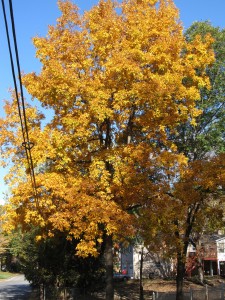Pignut hickory (Carya glabra) is a medium to large tree that you may fortunately inherit when purchasing property. Pignut deserves a better name like “smooth bark hickory”. The species is commonly found in upland forests.
Pignut hickory prefers fertile well-drained soil and in full sun to partial shade. A young seedling trees start off slowly from a large taproot. This also makes most hickory species difficult to transplant.
Pignut hickory grows 50 to 60 feet high by 25 to 35 feet wide, consisting of a long straight trunk, ascending vase-shaped branching, and rounded canopy. The furrowed bark on the trunk is gray to grayish-brown which becomes moderately rough with age.
The alternate pinnately compound leaves are 8 to 12 inches long , commonly 5 leaflets, sometimes 7. The medium green summer foliage turns deep golden yellow color in the fall. Short drooping male catkins flowers appear in mid to late April in the Southern Appalachian region (USDA zones 6 and 7). Trees produce large 1½ to 2 inch long nuts which are bitter tasting. Many small mammals rely on the pignut hickory for food and shelter.
The wood is valued in furniture-making and in barbequing to capture the hickory flavor. While disease and pest problems are rarely serious, a number of butterfly larvae feed on its dense compound foliage in late summer.


 Posted in
Posted in 
